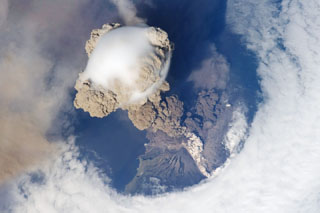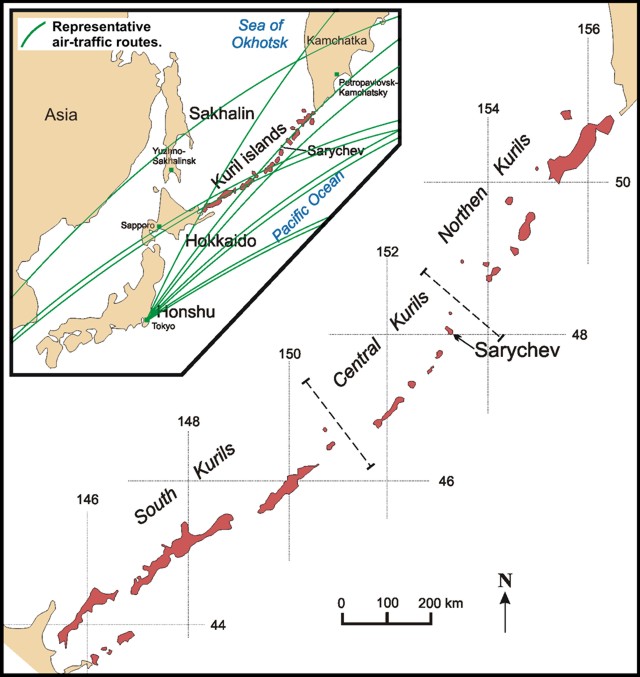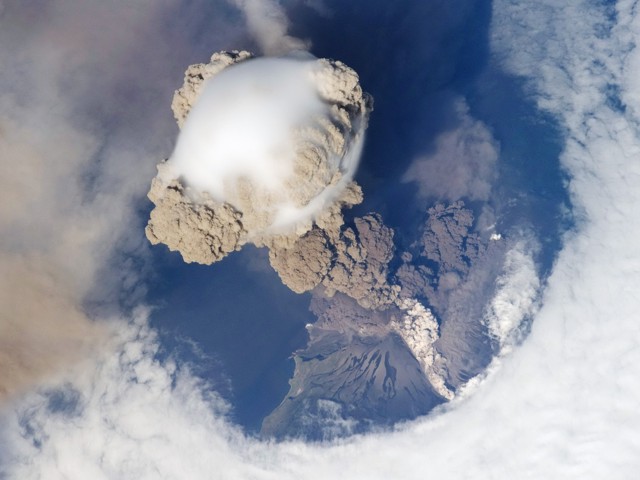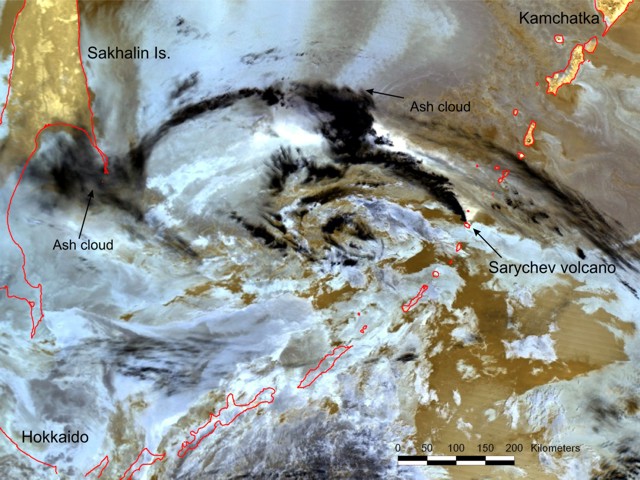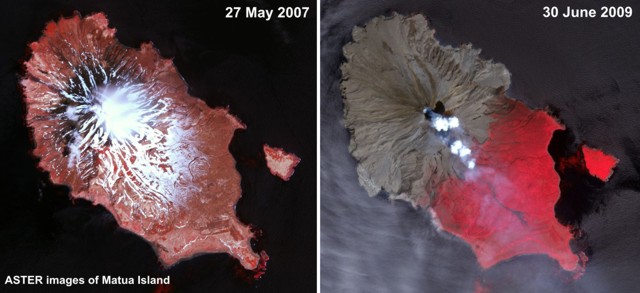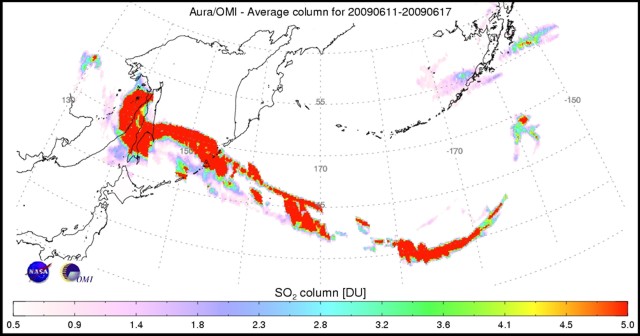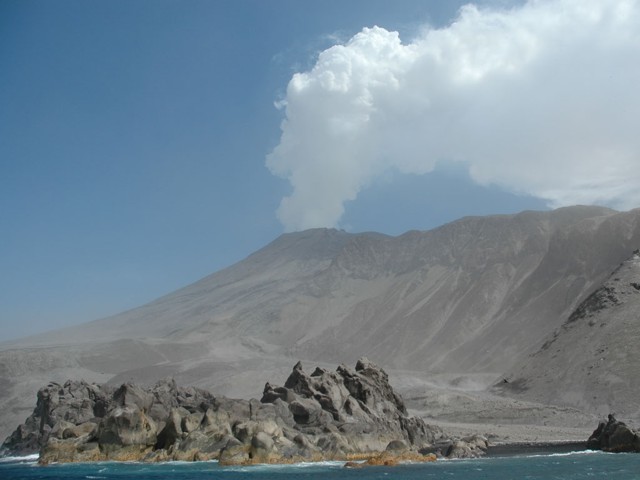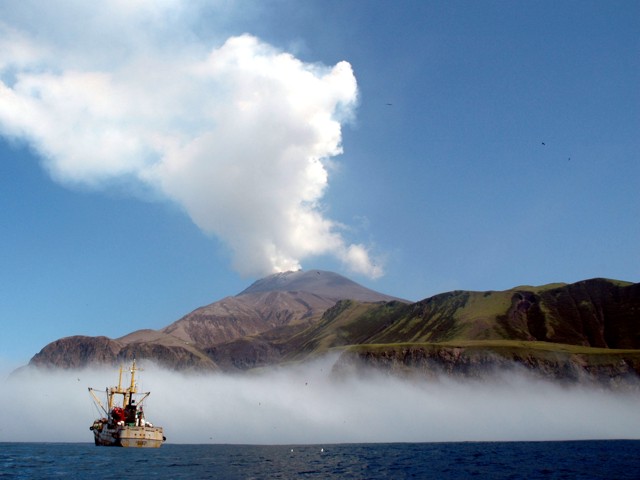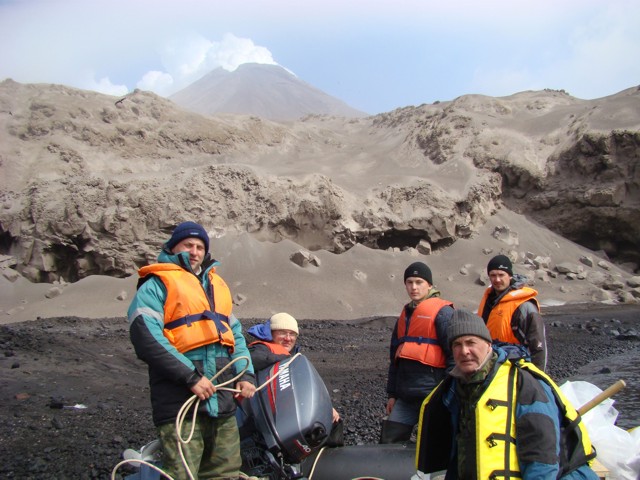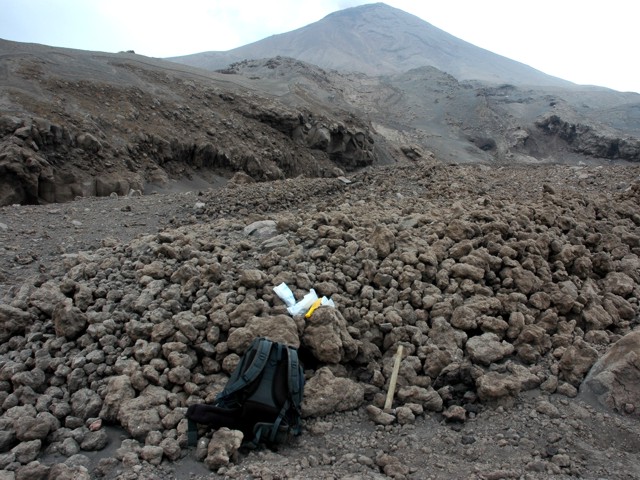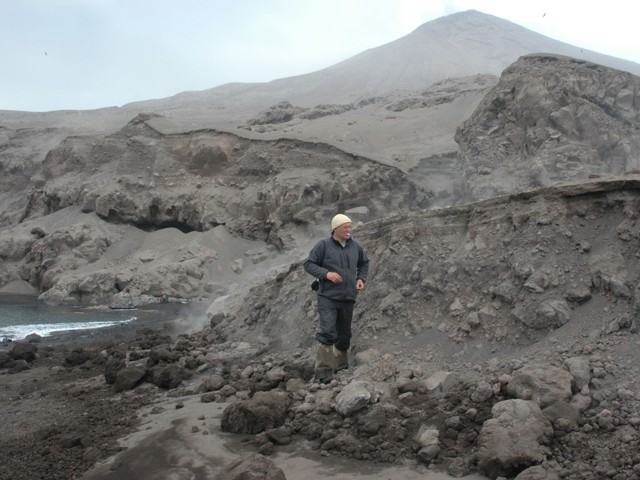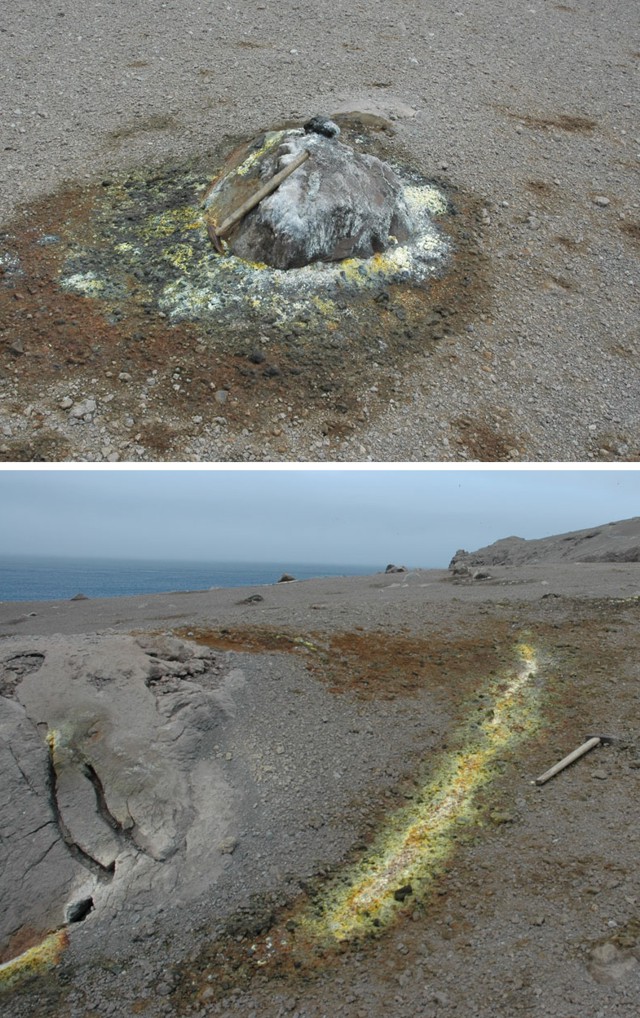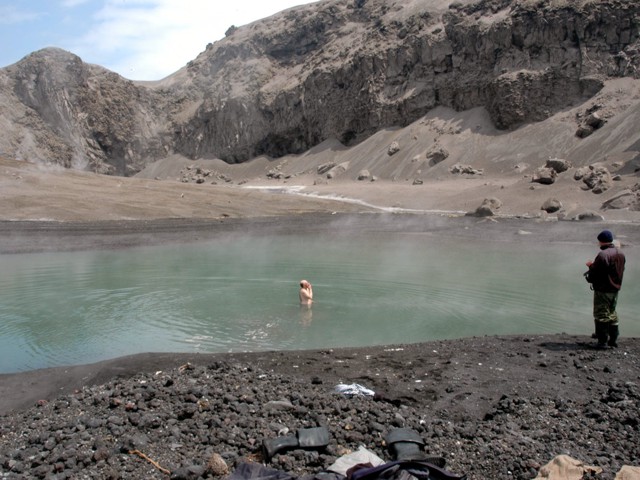Report on Sarychev Peak (Russia) — June 2009
Bulletin of the Global Volcanism Network, vol. 34, no. 6 (June 2009)
Managing Editor: Richard Wunderman.
Sarychev Peak (Russia) Widespread plumes from large 11-16 June 2009 eruption
Please cite this report as:
Global Volcanism Program, 2009. Report on Sarychev Peak (Russia) (Wunderman, R., ed.). Bulletin of the Global Volcanism Network, 34:6. Smithsonian Institution. https://doi.org/10.5479/si.GVP.BGVN200906-290240
Sarychev Peak
Russia
48.092°N, 153.2°E; summit elev. 1496 m
All times are local (unless otherwise noted)
On 11 June 2009 one of the largest historical eruptions in the Kuril Islands began?from Sarychev Peak (figure 1). A report from the Sakhalin Volcanic Eruption Response Team (SVERT) covered events through June, and included both remote-sensing and on-the-scene observations by Russian scientists. Other contributors include astronauts and remote-sensing specialists. Synonyms for the volcano include Fue-san, Matsuwa-jima, Matua-jima, and Sarnicheff.
Monitoring. Volcano monitoring is conducted by SVERT in the southern and central Kurils, and by KVERT in the northern Kurils (figure 1). The region is well known for severe weather, including summertime cloudy and foggy conditions; volcano monitoring has depended heavily on remote-sensing methods.
With respect to civil aviation, the Kuril Islands are the responsibility of the Tokyo Volcanic Ash Advisory Center (VAAC). A zone without designated VAAC jurisdiction over N-central Russia is ~ 1,400 km N. The substantial plumes caused concern about that zone's ambiguous status and the whereabouts of Sarychev's ash.
This part of the North Pacific is sparsely populated but is one of the world's most heavily traveled air corridors, crossed by flights linking Europe and North America to northern Asia (including Japan, parts of China, Hong Kong, and Korea). Injecting ash into these flight routes, Sarychev's eruption triggered diversions or delays to an unknown number of flights. Reliable sources indicated that some aircraft diversions over Russia, and other unexpected factors, cost as much as $100,000 USD per flight.
Precursors and initial eruption, 11 June 2009. Before the June 2009 eruption the volcano was dormant with substantial fumarolic activity. Visitors looking into the crater in August 2008 encountered thick fog, but did heard noises. On 6 June 2009 specialists came to the island to service an autonomous GPS station. Photographs documented increased gas emissions.
SVERT's report stated that the first signs of eruption came as a result of satellite observations acquired on 11 June 2009. Distinct then were both a thermal anomaly and weak ash emissions. During the eruption, ashfalls were widespread and noted at sites including Raikoke, Rasshua, Ushishir, Ketoi, the Simushir islands, the northern part of Urup Island, and widespread on Sakhalin Island.
On the night of 11-12 June, the scientific research ship George Steller passed near the island without anyone noticing an eruption, according to an oral report from the expedition chief Vladimir Burkanov.
Space Station photograph, 12 June 2009. A stunning photo of the plume taken on 12 June 2009 (figure 2) from the International Space Station (ISS) shows not only a highly complex ash cloud, but at least two or three distinct (different colored) volcanic clouds hugging the ground surface and traveling radially out from the vent. One is an unmistakable, light-colored pyroclastic flow, narrowing as it progresses out over the island until ultimately hidden by the edge of the weather clouds. Another set are broader, dark-colored clouds, presumably other pyroclastic flows.
The vertical plume looks dense and well confined; absent is the strongly spreading upper region common in many eruptive plumes (an umbrella cloud). The top of this cloud is bulbous, and trailing below it is a narrower, columnar lower segment colored in shades of brown and cream. At the time of this writing no clear analysis of the plume height has come to our attention. Older dispersed plumes are also apparent at distance (some at the left edge of this photo) and on satellite imagery from 12 June, with airborne ash covering a considerable area and extending in more than one direction.
Capping the ash cloud's bulbous top and in a ring just below it, lies a strikingly smooth, white portion of the plume, a feature called a pileus cloud (figure 2). It results from a slab of uncontaminated air pushed upward ahead of the rapidly rising darker zone. Pileus clouds sometimes form above mountain tops and convectively rising weather clouds. For the pileus cloud to form, the lifted air layer must have sufficient moisture (relative humidity). The underlying clouds often punch through the pileus clouds, a process that seems to have started here. The lower clouds that result are sometimes described as cloud skirts (the ring in this case).
The hole in the weather clouds centered above the volcano is likely in part due to meteorological conditions; such holes often occur similarly centered over islands in the Kuril chain. This may result, for example, from an island's landmass warming moist air or forcing it upwards to mix with dryer air, resulting in a local loss of cloud cover; such an effect might combine with downwind eddies. A broader 12 June ISS image shows a series of holes in regional weather clouds in a pattern aligned broadly over the Kuriles. Another explanation, with many adherants, is that the hole may have been caused or influenced by effects associated with dynamics of the eruption and plume propagation (Wilkinson, 2009).
The opportune ISS flyover resulted in 29 still images of the eruption taken over a 1-minute interval. NASA used the photos to create a series of animations, also available on the NASA Earth Observatory website. The ISS orbits at ~ 400 km altitude and ~ 27,500 km/hour. Patrick Vantuyne created a red-blue stereo image of the 12 June plume, posted by NASA as a "Picture of the Day."
Satellite-based observations. SVERT reported that the energetic phase of the eruption, during 11-16 June, encompassed more than ten large explosions (figures 3 and 4). Resulting ash clouds rose up to altitudes of 8-16 km and, according to some estimates, up to 21 km. Ash plumes stretched N to W for 1,500 km, and E for more than 3,000 km. Comparative analysis of ASTER-Terra satellite images indicated newly formed territory amounted to 1.4 km2. The area of island covered by June 2009 pyroclastic flows was more than 8 km2. The preliminary estimated minimum volume of eruptive rock was 0.4 km3.
Broader imagery of the region also indicated more diffuse high-altitude ash clouds. Starting on 12 June, the ash spread hundreds of kilometers both E and W and to lesser extent N, a large elongate mass high in the atmosphere that closed off a huge critical area to commercial air carriers and created new problems not seen before by aviation authorities.
According to Simon Carn, the Ozone Monitoring Instrument (OMI) on NASA's Aura satellite tracked a sulfur dioxide plume across the northern Pacific from Sakhalin Island and mainland Russia and E as far as Alaska (figure 5). Carn's tentative conclusion was that the eruption was also the largest sulfur dioxide event so far in 2009.
By early July both atmospheric lidar instruments and the CALIPSO limb-sounding satellite had documented extended aerosol layers at 10-20 km altitude over the Northern Hemisphere. There were two potential sources for these aerosols, fires and the Sarychev Peak eruption. Fires due to biomass burning were seen around this time in both the Yukon and Alaska. Fire-generated aerosols are now known to reach 20 km altitudes (Mike Fromm, personal communication, and Fromm and others, 2004). According to Fromm, the Sarychev Peak eruptions must have at least contributed to high-altitude aerosols. As recent as mid-August, the atmospheric limb-sounding satellite CALYPSO had detected pronounced aerosol layers at 22-23 km altitude, layers also seen on MODIS visible-wavelength imagery. Fromm concluded the aerosol burden was larger than the substantial August-September 2008 eruption at Kasatochi (Alaska).
The microwave limb-sounding (MLS) satellite Aura can detect multiple gases. According to a NASA website, in mid-June 2009 it detected clear signals of both SO2 and HCl across a large span of the North Pacific.
Continuing activity during 16-28 June 2009. After 16 June, the eruptions entered a less energetic stage. Weak explosions continued and contained small amounts of tephra. The SVERT team visited the island during 26-28 June. Intense gas emissions came from still-hot deposits. Satellite data confirmed these gas emissions, which continued through at least 20 July. Field work and satellite observations led the team to consider the eruption to be VEI 4.
Good views of the island were obtained from the sea during the 26-28 June visit by SVERT (figures 6-8). One component of fieldwork involved the GPS-aided mapping of pyroclastic deposits seen along the seashore. The team used an inflatable boat to access the shoreline (figure 9). The bulk of pyroclastic flows reached the sea (figures 10 and 11), and although wave action had substantially eroded the deposits along the coastline, the deposits clearly continued out into the sea. Weakly eroded underwater pyroclastic flows sometimes returned distinctive reflections on echo soundings. The soundings and other observations also revealed submerged deposits emitting gases and still-stirring hydrothermal exchanges.
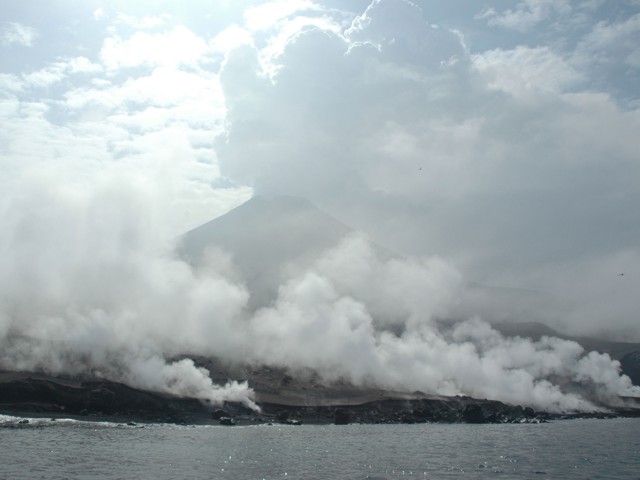 |
Figure 7. Photos of steam rising from the pyroclastic flows as seen from the N at some time during 26-28 June. The steaming peak is faintly visible in the background. Courtesy of SVERT. |
The field inspection revealed three pyroclastic flows from the eruption. The team also recognized other pyroclastic material, including volcanic bombs, scoria flows, and ash. Compositionally, the field analysis suggested the eruptions were basaltic andesite. In accord with the density of the fresh blocky deposits along the sea cliff, and the clasts within them (figure 11), the team saw no floating pumice.
The intense fumarolic discharges escaping the pyroclastic flows reached ~ 500°C. Fumaroles were seen most frequently associated with impacts from large volcanic bombs, and from fissures. Areas of fumarolic exhalation included sublimated minerals such as native sulfur (figure 12). The team also encountered a pond with hot water (figure 13).
Biological impacts. Prior to the eruption, the island was teeming with life and the SVERT team photographically documented many biological impacts (eg., surviving birds congregated at damaged or destroyed rookeries). The eruptions of June 2009 divided Matua Island into two sectors with a sharp and nearly linear boundary between them (eg., figure 5). On the NW side, nearest Sarychev Peak, its eruption left a dead zone. Many plants were buried by hot tephra, leaving a landscape devoid of vegetation on the current ground surface. This dead zone was bounded to the S by a deep ravine where a large mudflow had occurred, destroying ferns, thick growths of alder, and grass cover.
To the SE, ashfall damaged small plants, including rhododendron, crowberry, cassiopea, and phylodoce. Perhaps 10-15% of sites visited there had ash over 10 cm thick. Especially near the dead zone, many small plants suffered burial, yet they continued to blossom. Blossoming cowberry was buried in areas with thick ashfall.
Among high brush in the S part of the island, alder generally suffered little, but in some areas of ashfall (between Kruglaya mountain and the slopes of the volcano) it showed some leaf damage. The leaves of mountain ash displayed yellow rims and discolored spots. High-grasses located in the SE sector were little affected by ashfall.
In the dead zone, some bird colonies remained on the old lava flows supporting the island's capes. It was difficult to estimate how many birds had died or lost nests. Many seagulls sat on the warm surfaces of the steaming pyroclastic flows. Wounded and dead seagulls found on the surfaces of pyroclastic flows were probably killed by burns after the eruption. Near the NW part of Matua Island, the team saw large flocks of sea birds aloft.
On the 28th, SVERT visited seal habitats on the S portion of the island where they counted 20 eared seals and 10 fur seals. On a cape along Matua's W coast they encountered another seven eared seals. The team found no living land animals on the NW sector. On the SE sector, they found dead mice and three dead foxes.
Additional geological background from SVERT. The modern edifice of Sarychev Peak occupies the bulk of Matua Island but is centered towards the NW (figure 5). The island's SE side is flat, with average elevations of 30-40 m. The island's S and E sides are covered with brush and grass.
Before 25 August 1945, Matua Island supported a Japanese army base with as many as 4,000 residents. After 1945, the Soviet army occupied the island and maintained meteorological and seismic stations until a sharp decline in inhabitants at the end of the 1990's. The island still contains runways and structures. In recent years, the only people on the island were occasional visitors.
The geologic literature discusses Pliocene basaltic andesite volcanoes in this region (including Toporkovyi Island and the SE part of Matua). It is probable that these are part of an ancient shield volcano. In the SE part of Matua Island is a somma of an ancient caldera (Gorshkov 1967; Markhinin 1964; Andreev and others, 1978), making Sarychev Peak an intracaldera stratovolcano. It is formed by alternating lava and tephra of mainly basalt to andesite composition (Gorshkov 1967; Andreev et.al 1978).
According to Gorshkov (1967), after the major 1946 eruption the crater had both a diameter and depth of ~ 250 m, with steep, sometimes overhanging crater walls and a floor of solid lava. Modern lava flows consisted of two-pyroxene basalts and basaltic andesites vented from the central cone, forming small tongues near the crater.
After the 1960 eruption, field observers encountered dense fog and were thus unable to describe the crater (Shilov, 1962). According to eye-witnesses, the crater's N walls may have collapsed.
The 1976 eruption included strong emissions. Lava flows extended the W, SW, and NW slopes (Andreev and others, 1978). This eruption left the crater with a diameter of ~ 200 m and a flat bottom at a depth 50-70 m below the rim.
References. Andreev, V.N., Shantser, A.E., Khrenov, A.P., Okrugin, V.M., and Hechaev V.N., 1978, Eruption of the volcano Sarychev Peak in 1976: Bull.of volcanological stations, no. 55, p. 35-40.
Casadevall, T., and Thompson, T., 1995, World map of volcanoes and principal aeronautical features (1:34,268,000): U.S. Geological Survey, Geophysical Investigations Map GP-1011.
Fedorchenko, V.I., Abdurakhmanov, A.I., and Rodionova, R.I., 1989, Volcanism of Kurile Island arc: geology and petrogenesis: M. Nauka, p. 239.
Fromm, M., Bevilacqua, R., Stocks, B., and Servranckx, R., 2004, New Directions: Eruptive transport to the stratosphere: add fire-convection to volcanoes: Atmospheric Environment, v. 38, p. 163-165.
Glavadskii, S.N., and Efremov, G.K., 1948, Eruption of the volcano Sarychev Peak in the November 1946: Bull.of volcanological stations, no. 15, p. 48-12.
Gorshkov, G.S., 1948, Volcano Sarychev Peak: Bull.of volcanological stations, no. 15, p. 3-7.
Gorshkov, G.S., 1967, Volcanism of the Kurile Island arc: M. Nauka
Markhinin, E.K, 1964, Sarychev volcano: Bull. of volcanological stations, no. 35, p. 44-58.
Shilov, V.N., 1962, The eruption of volcano Sarychev Peak in 1960: The book of Sakhalin. v. 12, p.143-149.
Wilkinson, M.J., 2009, Sarychev Peak Eruption, Kurile Islands (caption): NASA Earth Observatory, posted 22 June 2009 (URL: http://earthobservatory.nasa.gov/IOTD/view.php?id=38985).
Geological Summary. Sarychev Peak, one of the most active volcanoes of the Kuril Islands, occupies the NW end of Matua Island in the central Kuriles. The andesitic central cone was constructed within a 3-3.5-km-wide caldera, whose rim is exposed only on the SW side. A dramatic 250-m-wide, very steep-walled crater with a jagged rim caps the volcano. The substantially higher SE rim forms the 1496 m high point of the island. Fresh-looking lava flows, prior to activity in 2009, had descended in all directions, often forming capes along the coast. Much of the lower-angle outer flanks of the volcano are overlain by pyroclastic-flow deposits. Eruptions have been recorded since the 1760s and include both quiet lava effusion and violent explosions. Large eruptions in 1946 and 2009 produced pyroclastic flows that reached the sea.
Information Contacts: Sakhalin Volcanic Eruptions Response Team (SVERT), Institute of Marine Geology and Geophysics (IMG & G) Far East Division Russian Academy of Sciences, 1B Science St., Yuzhno-Sakhalinsk, 693022, Russia (URL: http://www.imgg.ru/); B.W. Levin, A.V. Rybin, M.V. Chibisoba, and V.B. Gur'yanov, IMG & G; N.G. Razzhigaeva, Pacific Institute of Geography, Far East Division Russian Academy of Sciences, 7 Radio St., Vladivostok, 690041, Russia (URL: http://tig.dvo.ru/tig/); International Space Station (ISS) Expedition 20 (astronauts Gennady Padalka, Frank De Winne, Roman Romanenko, Robert Thirsk, Michael Barratt, Nicole Stott, Tim Kopra, and Koichi Wakata) (URL: http://www.nasa.gov/mission_pages/station/expeditions/expedition20/); Simon A. Carn, Department of Geological and Mining Engineering and Sciences, Michigan Technological University, 1400 Townsend Drive Houghton, MI 49931 USA; Mike Fromm, Computational Physics, Inc, 2750 Prosperity Ave, Fairfax, VA 22031, USA; NASA Astronomy Picture of the Day (URL: http://apod.nasa.gov/apod/ap090625.html); NASA Earth Observatory (URL: http://earthobservatory.nasa.gov/).

